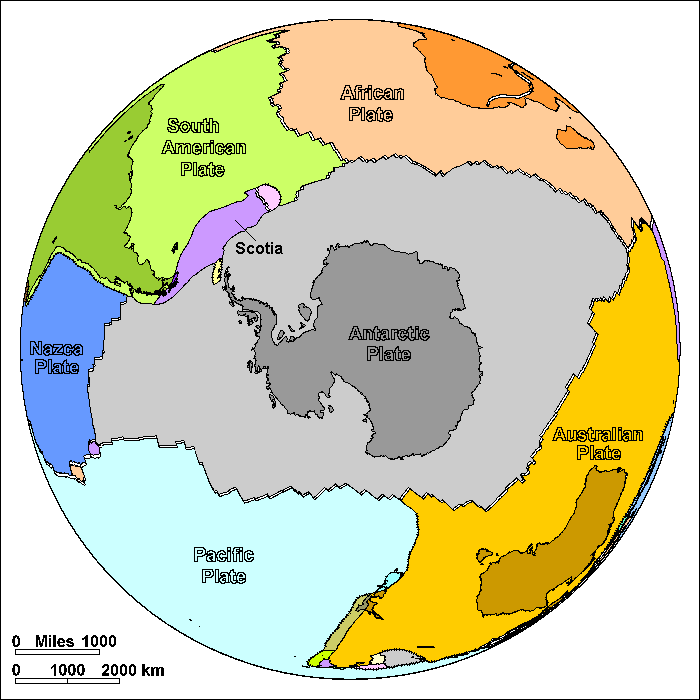The Antarctic Sea Floor
Steven Dutch, Professor Emeritus, Natural and Applied Sciences, University of Wisconsin - Green Bay
Plates grow by pulling apart at the mid-ocean ridges and sinking back into the earth's interior at the tranches, mostly around the rim of the Pacific. As plates grow, they create strips of progressively older crust on either side of the ridge. We can determine the age of the ocean floor by drilling into it an retrieving samples, but mostly because newly formed crust is slightly magnetized by the earth's magnetic field, and we can compare the magnetism of the sea floor with the history of changes in the earth's magnetic field.
On the colored diagrams, land is brown, and submerged continental crust is tan. The bluish gray area, labeled Submarine Volcanic Plateau, includes large areas of sea floor where thick accumulations of lava flows built up. This color also indicates areas where the exact age of the sea floor is uncertain.
The earth has two kinds of crust. The continents are mostly made of thick granite. When continents pull apart, the gap is filled by thin crust made of basalt. In plate tectonics, a continent is any piece of continental crust surrounded by oceanic crust or plate boundaries. New Zealand is a continent. Unlike most continents, most of New Zealand is submerged. Also, unlike Africa and South America, it does not fit neatly against Australia. The submerged northern portion, called the Lord Howe Rise, is actually a collection of smaller fragments that moved in a complex way so the present shape is not the original shape.
The ocean floors show a remarkable degree of regularity. The crest of the mid-ocean ridges is at an average depth of 2700 meters, and the 3000 meter contour on the map reveals most of the crest. As newly formed ocean crust cools, it becomes denser and sinks, until it finally sinks to an average depth of 5500 meters. The broad deep areas about 5000-6000 meters below sea level are called abyssal plains and are the flattest areas on Earth. The very deepest parts of the ocean, up to 11 kilometers deep, make up a very tiny part of the sea floor. They are not out in the middle, like one might expect in a bowl. Instead they are long, narrow trenches close to a continent or island chain. The trenches mark convergent plate boundaries where oceanic crust sinks back into the earth's interior.
Antarctica was part of eastern Gondwanaland along with Madagascar, India and Australia. Eastern Gondwanaland broke off of Africa about 180 million years ago, and not long afterward, India and Madagascar broke off. Finally, Australia and New Zealand broke off around 70 million years ago. As a result, Antarctica is almost entirely surrounded by divergent plate boundaries.
As North America, South America, and Antarctica spread away from Africa, they also pulled away from each other. The gaps were filled by oceanic crust that now forms the tongue-like Caribbean and Scotia Plates.

Possible Coloring

Labeled Features
In addition to the large plates, significant small plates are labeled. Very small plates are not labeled.

Return to Geology Coloring Book Index
Return to Professor Dutch's Home Page
Created 25 July 2009, Last Update 15 January 2020